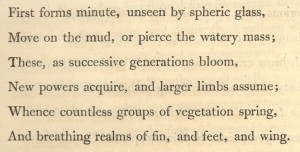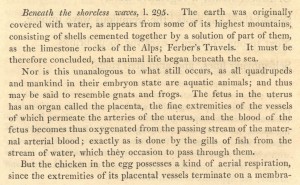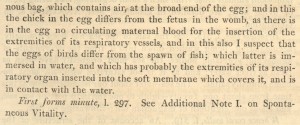Erasmus Darwin, grandfather of Charles Darwin, was born near Nottingham on December 12, 1731. He was educated at Cambridge and Edinburgh and settled first near Lichfield and later at Derby. A remarkable polymath, he became a best selling poet during the same years that he worked as a country doctor, naturalist, medical botanist, and inventor. Darwin expounded one of the earliest theories of evolution (“all vegetables and animals now living were originally derived from the smallest microscopic ones”), and he described the importance of sexual selection to continuing changes within species (“the final cause of this contest among males seems to be, that the strongest and most active animal should propagate the species, which should thence become improved”). His two most important technical works are Zoonomia (1794), a medical textbook punctuated with reflections on philosophy, natural history, and human life and Phytologia (1800), a scientific discussion of agriculture and gardening. His book length poems, The Botanic Garden (1789-91) and The Temple of Nature (1803), were widely read and even more widely discussed. His friends and associates included a pantheon of leading lights in a wide variety of fields: Jean-Jacques Rousseau, Joseph Priestley, Josiah Wedgwood, James Watt, Dr. Johnson, the poet Anna Seward (who also wrote Memoirs of the Life of Dr. Darwin), and R. L. Edgeworth, father of Maria.
Darwin was one of the founders of the well known Lunar Society, second only to the Royal Society in its importance as a gathering place for scientists, inventors, and natural philosophers during the second half of the eighteenth century. Although he clearly considered himself a serious medical practitioner and scientist, Darwin wrote many of his major works in heroic couplets and stressed the role of sexuality–often humorously–in all reproduction. In addition, he was consistently willing to
attribute the possibility of emotion to plants. He expressed great interest in the work of Volta and Galvani on muscular contraction, arguing in 1791 that electricity was the basis for all nerve impulses. He recorded accurate observations on subjects as wide ranging as photosynthesis, neurology, meteorology, geology, and psychology. Darwin exerted a powerful influence on Wordsworth, Coleridge, Shelley, and Mary Shelley among other literary figures. Wordsworth cited him as a source for “Goody Blake and Harry Gill” in Lyrical Ballads (1798) and Coleridge claimed that Darwin possessed “perhaps, a greater range of knowledge than any other man in Europe, and is the most inventive of philosophical men.” Coleridge, however, also coined the term darwinizing, meaning to speculate wildly, in reference to Darwin’s evolutionary ideas. In addition, Wordsworth and Coleridge clearly had Darwin, among others, in mind when they attacked the “gaudiness” of eighteenth-century poetic diction in the “Preface” to Lyrical Ballads. Darwin was clearly in the minds of the Shelley Circle (Mary, Percy, Lord Byron, Polidori) during the Frankenstein summer of 1816; he is referred to in Percy’s “Preface” to the 1818 edition and in Mary’s introduction to the 1831 edition of the novel. Even Keats, who studied medicine before turning to poetry, was affected by the power of Darwin’s ideas about an organic unity that linked plants, animals, and human beings.
The earlier Darwin is clearly the natural historian most directly responsible for many of the ideas that made their way into a wide range of Romantic literary writings. He is referred to in the introduction to Mary Shelley’s 1831 Frankenstein (Smith 22), was praised by Coleridge as having “a greater range of knowledge than any man in Europe” (Barber 210), and was used by Wordsworth in”Goody Blake and Harry Gill” (Wordsworth 688). Erasmus Darwin’s capacious and synthetic mind worked consistently to question the notion of immutable species. He not only personified and humanized the sexual life of plants (in “The Loves of the Plants”), for which he was parodied and reviled, he also anticipated the outlines of his grandson’s subsequent theory of evolution. In his Phytologia (1800), Erasmus Darwin described the “muscles, nerves and brains of vegetables,” concluding that plants have sensations and volition, “though in a much inferior degree than even the cold-blooded animals” (133). In The Temple of Nature (1803), he describes the Lycoperdon tuber, a plant that “never rises above the earth, is propagated without seeds by its roots only, and seems to require no light. Perhaps many other fungi are generated without seed by their roots only, and without light, and approach on the last account to animal nature” (48).
Darwin also argues, in Zoonomia (1794), that nature is full of complex forms of variation and metamorphosis within the lives of single creatures as well as types. He cites caterpillars changing into butterflies, tadpoles into frogs, the “feminine boy” into the “bearded man,” and the “infant girl” into the “lactescent woman” as examples of dynamic and mysterious changes in individuals (Zoonomia 2: 233). He also marvels at “great changes introduced into various animals by artificial or accidental cultivation, as in horses” (2: 233). This line of thinking allows him to conclude that “all animals have a similar origin, viz. from a single living filament” and that “it is not impossible but the great variety of species of animals, which now tenant the earth, may have had their origin from the mixture of a few natural orders” (2: 230-31). He even goes so far as to cite David Hume’s claim that “the world itself might have been generated, rather than created” with the resulting conclusion that all organisms would then derive not only from earlier organisms but ultimately from inorganic substances (2: 247).
Organic life beneath the shoreless waves
Was born and nurs’d in ocean’s pearly caves;
First forms minute, unseen by spheric glass,
Move on the mud, or pierce the watery mass;
These, as successive generations bloom,
New powers acquire and larger limbs assume;
Whence countless groups of vegetation spring,
And breathing realms of fin and feet and wing.
Hence on green leaves the sexual Pleasures dwell,
And Loves and Beauties crowd the blossom’s bell;
The wakeful Anther in his silken bed
O’er the pleas’d Stigma bows his waxen head;
With meeting lips, and mingling smiles, they sup
Ambrosial dew-drops from the nectar’d cup;
Or buoy’d in air the plumy Lover springs,
And seeks his panting bride on Hymen-wings.
(Temple of Nature, 2, 263-70)
Darwin was roundly attacked, as had been Linnaeus before him, for this tendency to compare the sex life of plants to human sexuality in this way. For Darwin, these erotic descriptions of plant love (and even plant lust) were an accurate analogue for human sexuality as well as a precisely detailed description of the way flowers actually operated. Indeed, almost all of Darwin’s claims about plant sexuality were based on his own direct observations. He often expanded his poetic rhapsodies on the sex life of plants with prose footnotes that also ascribe a wide range of intentionality and emotion to the plant kingdom:
The vegetable passion of love is agreeably seen in the flower of the parnassia, in which the males alternately approach and recede from the female; and in the flower of nigella, or devil in the bush, in which the tall females bend down to their dwarf husbands. But I was this morning surprised to observe . . . the manifest adultery of several females of the plant Collinsonia, who had bent themselves into contact with the males of other flowers of the same plant in their vicinity, neglectful of their own (“Economy of Vegetation,” 4, 121 n.)
Claims like these about plant life consistently suggest that willfulness, intention, and pleasure all extend – albeit in diminished forms – from humans to animals to plants, and even beyond.
More important for my argument than Darwin’s specific descriptions of the sexual life of plants are his views, most clearly summarized in the poetry and footnotes of The Temple of Nature (1803) about natural pleasures. In this work, Darwin clearly describes pleasure in any one part of animate creation as an aspect of pleasure extending through the whole of the terrestrial biosphere:
From the innumerable births of the larger insects, and the spontaneous productions of the microscopic ones, every part of organic matter from the recrements of dead vegetable or animal bodies, on or near the surface of the earth, becomes again presently re-animated; which by increasing the number and quantity of living organisms, though many of them exist but for a short time, adds to the sum total of terrestrial happiness” (Temple, 189 n.)
Pleasure in the entire biotic realm is increased not only by the prolific reproduction of “insects” (the word means “small creatures” to Darwin) and microscopic organisms but by the death and organic regeneration of larger creatures: “The sum total of the happiness of organized nature is probably increased rather than diminished, when one large old animal dies, and is converted into many thousand young ones; which are produced or supported with their numerous progeny by the same organic matter” (Temple, 190-91 n.).
Darwin also notes that the Pythagorean belief in the transmigration of souls derives merely from the organic and “perpetual transmigration of matter from one body to another, of all vegetables and animals, during their lives, as well as after their deaths” (191 n.). This chemical and organic movement of elements through the bodies of living creatures leads, over eons, to a unified and complete “system of morality and benevolence, as all creatures thus became related to each other” (192 n.) in terms of the matter that composes them. What Darwin calls the “felicity of organic life,” is a function of the “happiness and misery of [all] organic beings”; this felicity, he says, depends ultimately, on “the actions of the organs of sense” and on “the fibres which perform locomotion” (194 n.). Every living thing, Darwin concludes, is subject to “immediate sources” of “pains and pleasures,” the encouragement or avoidance of which might “increase the sum total of organic happiness” (194-95 n.). Pain and pleasure, he goes on to argue, are a function of the expansion and contraction of nerve and muscles fibers of sensation, organic elements which exist in all living things, albeit in a variety of forms and intensities. All emotional responses – pleasure, pain, happiness, sadness – are thus based solely on the motion of material parts of each life form.
Finally, and perhaps most dramatically, Darwin’s understanding of geology leads him to conclude that the planet itself is a record of the pleasures of earlier ages of animate beings:
Not only the vast calcerous provinces . . . and also whatever rests upon them . . . clay, marl, sand, and coal . . . gave the pleasure of life to the animals and vegetables, which formed them; and thus constitute monuments of the past happiness of these organized beings. But as those remains of former life are not again totally decomposed . . . they supply more copious food to the successions of new animal or vegetable beings on their surface . . . . and hence the quantity or number of organized bodies, and their improvement in size, as well as their happiness, has been continually increasing, along with the solid parts of the globe (Temple, 195-96 n.)
More dry land over eons, more living things century upon century, more happiness produced from millennium to millennium. At this point, Darwin breaks down the boundary between organic and inorganic as part of his wider economy of nature, what we might now call his “ecology.” Material processes, compounds, and elements—which he always describes in fundamentally chemical terms (clay, sand, coal, heat, oxygen, hydrogen, carbon, phosphorus)—compose, decompose, and re-compose, first into inorganic, then into organic, and ultimately into animate creatures, including human beings.
Darwin also argues that the plant and animal kingdoms are connected by the possibility of sensation. In Zoonomia, he describes “Vegetable Animation”: “The fibres of the vegetable world, as well as those of the animal, are excitable into a variety of motions by irritations of external objects. This appears particularly in the mimosa or sensitive plant, whose leaves contract on the slightest injury ” (I, 73).2 But the “fibres” responsible for sensation are also related to pleasure: “when pleasure or pain affect the animal system, many of its motions both muscular and sensual are brought into action . . . The general tendency of these motion is to arrest [i.e. stabilize] and to possess the pleasure, or to dislodge or avoid the pain” (I, 31). The conclusion Darwin draws is obvious: “the individuals of the vegetable world may be considered as inferior or less perfect animals” (I, 73).
The Botanic Garden (delicate sex, animal mimicry, and ancient symbols)
Venus fly-trap (from The Botanic Garden) occasioned much debate because of the appearance of “sensation ” plants.
Darwin on the “sensitive plant” (mimosa)
Erasmus Darwin and the Frankenstein “mistake”
Erasmus Darwin (Berkeley)
Erasmus Darwin (Victorian Web)
Erasmus Darwin (Penn Frankenstein hypertext)





